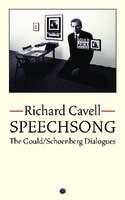Speechsong
The Gould/Schoenberg Dialogues
| dc.contributor.author | Cavell, Richard | |
| dc.date.accessioned | 2020-03-27 17:31:01 | |
| dc.date.accessioned | 2020-04-01T08:52:36Z | |
| dc.date.available | 2020-04-01T08:52:36Z | |
| dc.date.issued | 2020 | |
| dc.identifier | 1007354 | |
| dc.identifier | OCN: 1147282108 | |
| dc.identifier.uri | http://library.oapen.org/handle/20.500.12657/22809 | |
| dc.description.abstract | "Speechsong is a work of imaginative musicology that addresses the engimas of Schoenberg and Gould, of singing and speaking, of Moses und Aron, of technology and being. Its point of departure is Gould’s last public performance, given at the Wilshire Ebell Theatre in Los Angeles, where a number of Schoenberg’s works were performed during his California exile. It is here, after that last performance, that Gould encounters a spectral Schoenberg in a staged conversation that explores Schoenberg’s travails in rethinking the fundamentals of Western music. This first part of Speechsong recalls Schoenberg’s operatic masterpiece, Moses und Aron, in which the divinely inspired Moses seeks the help of his brother to relate his vision: Moses speaks and Aron sings. Written as a twelve-tone composition, the opera produces an involution of harmonics that was Schoenberg’s response to Richard Wagner’s diatribes about synagogue noise. For Gould, Schoenberg’s is a formalist revolution; Schoenberg’s life, however, suggests that it was a search for personal and political freedom. The second half of Speechsong is a critical essay in twelve “moments” that re-articulates the staged conversation as an inquiry into the intersections of music and mediation. Gould’s turn to the recording studio emerges as a post-humanist inquiry into recorded music as a repudiation of the virtuoso tradition and a liberation from unitary notions of selfhood. Schoenberg’s exodus from musical tradition likewise takes his twelve-tone invention beyond musical performance, where it emerges, along with Gould’s soundscapes, as a prototype of acoustic installations by artists such as Stephen Prina and Cory Arcangel. In these works, music abandons the concert hall and the exigencies of harmony for an acoustic space that embraces at once the recordings of Gould and the performances of Schoenberg that have found their home on the internet." | |
| dc.language | English | |
| dc.subject.classification | thema EDItEUR::A The Arts::AV Music::AVL Music: styles and genres::AVLA Art music, orchestral and formal music | en_US |
| dc.subject.classification | thema EDItEUR::3 Time period qualifiers::3M c 1500 onwards to present day::3MP 20th century, c 1900 to c 1999 | en_US |
| dc.subject.other | Glenn Gould | |
| dc.subject.other | Arnold Schoenberg | |
| dc.subject.other | music compositio | |
| dc.subject.other | radio | |
| dc.subject.other | twentieth-century music | |
| dc.subject.other | recording techniques | |
| dc.subject.other | Sprechstimme | |
| dc.title | Speechsong | |
| dc.title.alternative | The Gould/Schoenberg Dialogues | |
| dc.type | book | |
| oapen.identifier.doi | 10.21983/P3.0267.1.00 | |
| oapen.relation.isPublishedBy | 979dc044-00ee-4ea2-affc-b08c5bd42d13 | |
| oapen.relation.isbn | 9781950192502 | |
| oapen.relation.isbn | 9781950192496 | |
| oapen.collection | ScholarLed | |
| oapen.pages | 154 | |
| oapen.place.publication | Brooklyn, NY |

